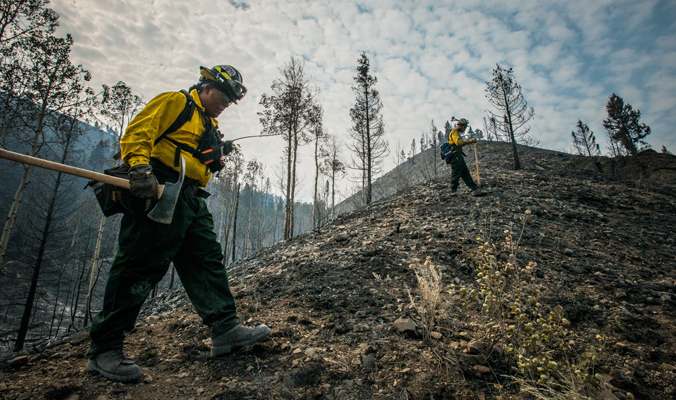In the December issue, the article “Hot Smoke, Cold Smoke” talks about wildfires and how they may impact backcountry skiing. It’s a topic that’s been on many Westerner’s minds with forest fires raging across California, Washington, Idaho and British Columbia over the summer.
Little is known about how fire affects snow stability, so Simon Trautman, director of the Sawtooth Avalanche Center in Idaho took a deeper look into the Beaver Creek Fire, which began in the Sawtooth Mountain Range just outside of Sun Valley on August 7, 2013. The fire started after a lightning strike ignited the surrounding pine forest northwest of Hailey, Idaho. It raged for nearly a month and consumed 114,900 acres of Sawtooth National Forest. Afterward, Trautman wanted to delve deeper into how the change in the landscape might impact winter conditions. These are his thoughts.

Firefighters look for hotspots. | Beaver Creek Fire, Hailey, Idaho | Photo: U.S. Department of Agriculture
The Beaver Creek Fire left its mark in many ways, both seen and unseen. People have asked what the ramifications are from an avalanche perspective and a realistic, if not satisfying answer is, “Well, it depends.” We can predict that the slopes that saw intense fire will generally have higher avalanche danger than similar slopes that were not burned.
Snow avalanches are a product of weather. Since meteorologists struggle to accurately forecast weather more than a day or two in advance, predicting avalanche hazard months in advance is futile. Luckily, terrain is relatively static and we can address whether or not the existing terrain is more or less apt to produce an avalanche.
If a slope is steep enough and a weak layer in the snowpack is uniform enough, avalanches can and will occur regardless of the amount of vegetation on a slope. That said, in some cases trees and brush can act as anchors on a slope and, maybe more importantly, they can disrupt snowpack uniformity by bisecting the layers, shading the snow, protecting slopes from the wind and dropping “tree bombs” on the slopes and providing insulation. This disruption makes heavily vegetated slopes less hazardous than sparsely or non-vegetated slopes. On the other hand, standing deadwood does not disrupt the snow layering as well as living vegetation as it increases a slope’s susceptibility to wind loading, a combination that promotes snow instabilities.
In most cases, a slope that has recently lost its vegetation will have a more uniform snowpack than before and consequently will be more hazardous than when vegetated. This will be especially critical on slopes that are natural avalanche start zones like slopes steeper than 35 degrees, hanging snowfields unsupported by the terrain below and in terrain susceptible to wind loading.

Firefighters extinguish the fire. | Beaver Creek Fire, Hailey, Idaho | Photo: U.S. Department of Agriculture
Interestingly, landslides—which are often steeper than the surrounding slope—can double as active avalanche start zones. After the 1998 fires in Yellowstone National Park, a subsequent landslide created a significant avalanche path that later killed two people. Based on the turbid condition of the Big Wood River this fall and aerial shots of the aftermath of the fire, my guess is that several of these features were recently created.
The human side of the equation is also important. Regardless of the weather and the avalanche danger, we will be recreating and working in a geography that is markedly different than before. Snow accumulation and deposition may vary from what we are used to, and those familiar and vetted routes may no longer be so familiar. We may be able to access terrain we have not been able to access in the past, however, terrain that is new, untested and potentially dangerous.
Poignant examples from the past remind us that when there’s a fundamental change in a familiar landscape like burned mountain forest, it’s essential to look at the terrain with fresh perspective. In 1906, false confidence of a trainmaster in Wellington, Wash. factored in to one of the worst avalanche catastrophes in American history claiming 96 lives. While snowbound below slopes that had recently burned, he insisted to his passengers that there was no need to evacuate because “there has never been a slide here in the history of the [track] and there never will be one.”
I am both excited and apprehensive about how the fire will affect avalanche conditions in the years to come. I look forward to the new ski lines and snowmobile routes that undoubtedly exist and I hope that we can head into those places with the attentiveness and vigilance that they demand.
This essay is written in warm memory and with help from the late Doug Abromeit.
—
Simon Trautman is the director of the Sawtooth Avalanche Center. He is rapidly learning that the world according to two-year-olds is much more fun.











Related posts:
Snow Shooter: Blake Jorgenson
Hot smoke, cold smoke: Wildfires burn both ways on the heels of a destructive season in the Northwes…
Snow Shooter: Mason Mashon
Snow Shooter: Jason Hummel